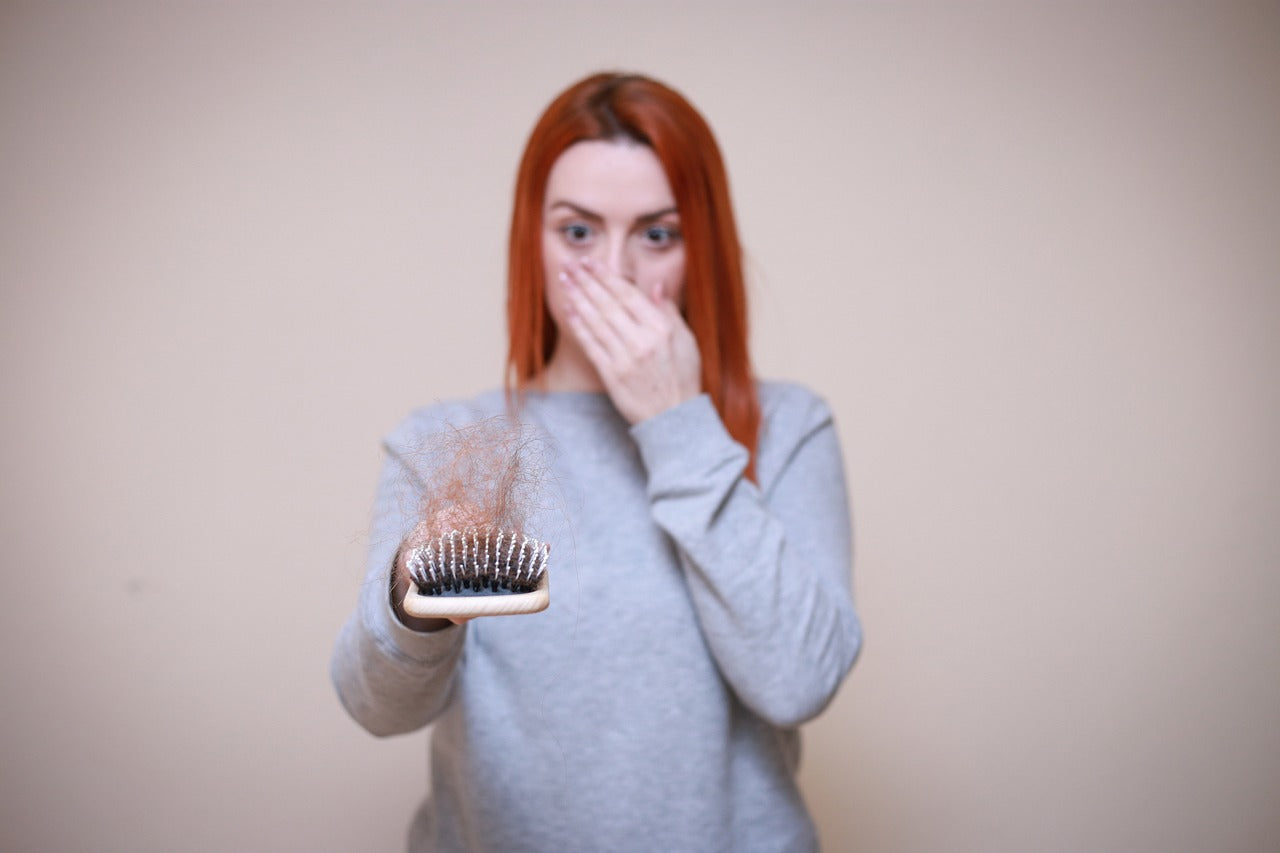Our hair is a vital component of our personal identity that reflects our individual style, cultural influences, and even personal milestones. Whether we wear it long, short, curly, or straight, our hair is deeply intertwined with how we perceive ourselves and how others perceive us.
However, for a significant number of individuals, the journey with their hair can be challenging. As per the Canadian Dermatology Association, about half of chaps face the challenge of male pattern baldness. Four out of five gents encounter some level of hair loss by the time they hit 70. On the women's front, the Association mentions that around 40% will notice their hair thinning in their 50s. It affects over 80 million Americans.
Hair loss can also transcend age and gender boundaries. In this blog post, we will learn about the scientific aspects of hair loss, particularly the role of hormones.
The Basics of Hair Growth
Hair growth is a continual process that follows a structured cycle. It consists of three main phases: anagen, catagen, and telogen.
Anagen Phase: The anagen phase is the active period of hair growth. During this phase, hair follicles generate new cells that allow the hair to grow. The length of the anagen phase varies; for example, scalp hairs can remain in this phase for several years, while body hairs have a much shorter anagen phase.
Thankfully, the duration of the anagen phase varies for different types of hair. For instance, the anagen phase for eyebrow and pubic hairs is much shorter compared to the phase for the hairs on your scalp.
During the anagen phase, your hair follicles are producing hairs that will continue growing until they are cut or reach the end of their lifespan and fall out. At any given time, about 90 percent of the hairs on your head are in the anagen phase.
Catagen Phase: Following the anagen phase, hair enters the catagen phase. This is a brief transitional stage where growth stops, and the hair follicle begins to shrink. Although it's a short phase, it serves as a preparation period for the hair to eventually shed.
It typically hangs around for roughly 10 days. In this stage, hair follicles contract that causes a slowdown in hair growth. The hair also disconnects from the base of the hair follicle but stays in position during its last days of growth.
Only about 5 percent of the hairs on your head are in the catagen phase at any given time.
Telogen Phase: The telogen phase is the resting stage of the hair cycle. In this phase, the hair is no longer actively growing, but it remains in the follicle. Eventually, the hair is shed, completing the cycle, and a new hair begins its journey in the anagen phase.
The telogen phase usually sticks around for about 3 months, with roughly 10 to 15 percent of your scalp hairs in this stage.
During the telogen phase, hairs don't grow, but they also don't usually fall out. It's also the time when new hairs begin to form in follicles that have recently released hairs during the catagen phase.
While some health experts refer to the telogen phase as the shedding phase, many scientists have divided this stage into two parts: the telogen and exogen stages.
Exogen Phase: The exogen phase is basically an extra part of the telogen stage in the hair growth process. In this phase, hair falls out from the scalp, often assisted by washing and brushing. It's normal to lose around 50 to 100 hairs per day during the exogen phase.
Lasting approximately 2 to 5 months, the exogen phase is a time when new hairs are emerging in the follicles while old hairs are shedding away.
The Role of Hair Follicles
Hair follicles, small structures in the skin, act as the command centers for hair growth. Each hair follicle operates independently of others, going through the growth cycle autonomously. The health and functionality of these follicles are vital for maintaining a healthy head of hair.
In simple words, a hair follicle is like a tube that wraps around the root and strand of a hair. These follicles are found in the top two layers of your skin. When you're born, you have more than 5 million hair follicles in your body, with over one million of them on your head. As you get older, hair grows out of these follicles.
Interestingly, a hair follicle is one of the few structures in your body that can stop working and then start working again (degenerate and regenerate). This process plays a role in the growth of hair on your body.
What is the function of a hair follicle?
The primary role of a hair follicle is to facilitate the growth of your hair. Along with promoting hair growth, hair follicles have other important functions:
Skin Repair: Hair follicles play a part in repairing your skin after a wound or injury.
Blood Vessel Formation (Angiogenesis): They contribute to the formation of new blood vessels.
Nervous System Cell Formation (Neurogenesis): Hair follicles are involved in the creation of new neuron cells in the nervous system.
How does a hair follicle aid in wound healing?
The cells within your hair follicles play a very important role in the healing process after a wound. When your body experiences an injury, these follicle cells, being close to the wound, swiftly move to the affected site to initiate the healing process. They work alongside your body's white blood cells in the immune system to assist in the healing process.
Where are hair follicles located?
Hair follicles are found wherever you have hair on your body. They originate in the first and second layers of your skin (epidermis and dermis). For terminal hair, like the hair on your scalp, eyelashes, and eyebrows, the follicles extend into the first and second layers of your skin and sometimes into the third layer (subcutaneous tissue).
What does a hair follicle look like?
A hair follicle resembles a long tube that houses your hair. It has a cylindrical shape with a rounded bottom in your skin. The top of the cylinder is an open hole where your hair grows out. Like a sock!
What does a hair follicle look like when it’s pulled out?
You can't pull out a hair follicle, as it's the structure within your skin that holds your hair. If you pull out a strand of hair, you might notice a bulb or a round ball (root) attached to the end of the hair strand. The root is surrounded by nerve fibers that allow you to feel when your hair moves or when you touch it. However, removing this root doesn't necessarily mean your hair won't grow back, as in most cases, it will.
While your hair color can change, your hair follicle, being a part of your skin, maintains the same color as your natural skin tone. The color of your hair follicle is unrelated to the color of your hair.
Hormonal Sensitivity of Hair Follicles
Among the various factors regulating hair growth, hormonal balance is particularly significant. Hair follicles exhibit sensitivity to changes in hormone levels, especially androgens such as testosterone and its derivative, dihydrotestosterone (DHT). The responsiveness of follicles to hormonal shifts can influence the duration of the anagen phase, impacting overall hair health and thickness.
Hormones and Their Role in Hair Growth
To comprehend the science behind hormonal hair loss, we must first familiarize ourselves with key hormones influencing the process. Four major hormones play pivotal roles in hair growth: Dihydrotestosterone (DHT), testosterone, estrogen, and progesterone.
Dihydrotestosterone (DHT)
DHT, derived from testosterone, is a very powerful hormone that significantly impacts hair follicles. While DHT plays an important role in early development, excessive levels, especially in genetically predisposed individuals, can lead to hair follicle shrinkage, resulting in finer and shorter hair during each growth cycle.
Testosterone
Testosterone, often associated with male characteristics, is a primary contributor to the development of body and facial hair. However, when testosterone is converted to DHT in the scalp, it can contribute to the miniaturization of hair follicles, potentially leading to hair thinning and loss.
Estrogen
Estrogen directly influences hair growth and loss by binding to receptors on hair follicles, promoting the growth phase. Women often experience thicker, healthier hair during pregnancy due to elevated estrogen levels. Conversely, during menopause, a decrease in estrogen leads to gradual hair thinning. Certain birth control pills may also impact hair follicles, causing excess hair to fall out.
Progesterone
Progesterone, another hormone with essential roles in the menstrual cycle and pregnancy, also influences hair growth. While its specific impact on hair health is complex, fluctuations in progesterone levels can contribute to hair thinning, especially in combination with other hormonal changes.
Thyroid Hormones
Fluctuations in thyroid hormone levels, either too high or too low, can disrupt the hair growth cycle, often resulting in diffuse hair loss across the entire scalp. Treating thyroid disorders can restore normal hair growth, but it may take several months to notice changes, depending on each follicle's growth cycle stage.
The Impact of Androgenetic Alopecia
Androgenetic alopecia, commonly known as male-pattern baldness or female-pattern baldness, stands out as the most prevalent cause of hair loss. It affects individuals of both genders and is largely influenced by genetic and hormonal factors.
DHT's Role in Androgenetic Alopecia
Miniaturization
DHT has the tendency to shrink hair follicles over time, a process known as miniaturization. This shrinking effect gradually reduces the lifespan of each hair cycle, leading to the production of finer and shorter hairs. Ultimately, affected follicles become incapable of producing robust, healthy strands.
Prolonged Telogen Phase
DHT not only shortens the growth phase (anagen) but also extends the resting phase (telogen). As a result, affected hairs spend more time in the resting phase before shedding, contributing to the overall thinning of the hair.
Genetic Predisposition
Androgenetic alopecia's connection to genetics is significant. Individuals with a family history of this condition are more likely to experience it themselves. The inheritance pattern involves a complex interplay of multiple genes, making it challenging to predict with certainty.
The manifestation of androgenetic alopecia varies between men and women. In men, it typically presents as a receding hairline and balding at the crown, creating the classic "M" shape. Women, on the other hand, often experience diffuse thinning across the crown, with the frontal hairline remaining intact.
More Simple Explanation
When testosterone changes into a hormone called dihydrotestosterone (DHT), it can affect your hair. Androgenetic alopecia happens when your genes make your hair follicles super sensitive to DHT. This makes the follicles shrink and produce thinner hair before eventually stopping the growth of new hairs.
You might have heard of this as male- and female-pattern baldness. In men, it often shows as a receding hairline and hair loss on the top of the head. For women, it means overall thinning, with more noticeable thinning where they part their hair.
How Hormones and Endocrine Disorders Affect Hair Growth | Study
Hormones control the growth, cycle, and density of our hair. Hair issues are quite common in medical practice, and they can lead to significant emotional distress based on societal and cultural norms. Consequently, disorders affecting the endocrine system can result in various changes in the physiological aspects of hair growth and cycling.
Conditions like hirsutism (excessive hair growth) and patterned hair loss can profoundly impact an individual's self-esteem. Dealing with these conditions requires a thorough approach to diagnosis and treatment. This discussion provides a brief overview of how hormones affect hair growth and the connection between different endocrine disorders and changes in hair. (Source)
Hormonal Changes Across Life Stages
Throughout life, our bodies undergo significant hormonal changes during key stages such as puberty, pregnancy, and menopause.
- Puberty
During puberty, the body experiences a surge in hormones, including an increase in testosterone. This surge can trigger changes in the hair growth cycle. While some individuals may notice an increase in hair thickness and growth, others might experience temporary shedding due to hormonal adjustments.
- Pregnancy
Pregnancy is another period marked by substantial hormonal changes, particularly boosted levels of estrogen. This surge in estrogen prolongs the anagen (growth) phase of the hair cycle, resulting in thicker, healthier hair for many pregnant individuals. However, postpartum hormonal fluctuations, especially a drop in estrogen levels, can lead to temporary hair shedding known as telogen effluvium.
- Menopause
Menopause marks the cessation of the menstrual cycle and a decline in estrogen and progesterone levels. The relative increase in androgens, particularly testosterone, can become more pronounced. This hormonal shift may contribute to hair thinning and loss in some women, resembling patterns seen in androgenetic alopecia.

Contributions to Temporary or Permanent Hair Loss
Temporary Hair Loss (Telogen Effluvium)
- Rapid hormonal shifts, as seen in pregnancy and postpartum periods, can lead to telogen effluvium.
- During telogen effluvium, a significant number of hairs prematurely enter the resting phase, leading to noticeable hair shedding.
- This type of hair loss is usually temporary, with the hair cycle returning to normal once hormonal levels stabilize.
Permanent Hair Loss
- In cases of androgenetic alopecia, hormonal changes during puberty and menopause can exacerbate genetic predispositions to hair loss.
- The impact of hormonal changes is more prolonged and contributes to the gradual miniaturization of hair follicles, leading to permanent hair loss in susceptible individuals.
Medical Conditions and Hormonal Hair Loss
Polycystic Ovary Syndrome (PCOS)
This is a common endocrine disorder among individuals assigned female at birth. It is characterized by hormonal imbalances, particularly elevated levels of androgens, the group of hormones that includes testosterone. The excess androgens in PCOS can have a direct impact on hair growth.
How PCOS Disrupts Hormonal Balance
Increased Androgens:
- Individuals with PCOS often have higher levels of androgens, leading to conditions such as hirsutism (excessive body hair) and male-pattern baldness.
- The increased androgens can negatively affect hair follicles, contributing to miniaturization and hair thinning.
Insulin Resistance:
- Insulin resistance, commonly associated with PCOS, can further exacerbate hormonal imbalances.
- Insulin resistance may contribute to higher levels of insulin in the blood, leading to increased androgen production.
Thyroid Disorders
Hypothyroidism
- Underactive thyroid (hypothyroidism) is associated with insufficient production of thyroid hormones.
- Reduced thyroid hormones can lead to a slowdown in the body's metabolic processes, affecting the hair growth cycle and potentially causing hair loss.
Hyperthyroidism
- Conversely, overactive thyroid (hyperthyroidism) is characterized by excessive production of thyroid hormones.
- The increased metabolic activity can accelerate the hair growth cycle, leading to hair thinning and increased shedding.
Other conditions such as adrenal gland disorders, ovarian tumors, and certain autoimmune diseases can also impact hormone levels.
Conclusion
If you've noticed changes in your hair, like thinning or increased shedding, it's important to talk to a healthcare professional or a dermatologist. They can help figure out the cause and recommend the right steps to address it.
Besides seeking professional advice, taking care of your overall health is very important for your hair. Eat balanced meals, manage stress, and follow a hair care routine that suits you.
At MV Supplements, we understand the importance of comprehensive hair care. We offer products like RU58841 and Pyrilutamide, which have gained attention for their potential in addressing hair loss concerns. If you're interested in exploring these products or seeking guidance on which might be right for you, visit our store. We prioritize your well-being and are here to assist you on your path to healthier, fuller-looking hair.





Leave a comment
This site is protected by hCaptcha and the hCaptcha Privacy Policy and Terms of Service apply.